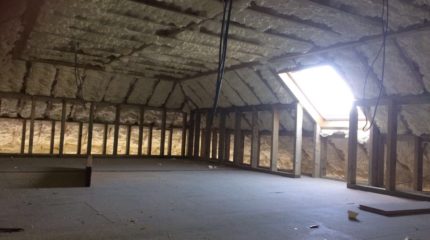How to Stop Damp with Spray Foam Insulation
About IcyneneMould and damp problems can be frustrating and expensive to fix. If a property starts to develop signs of mould or damp, it’s a sign there’s too much excess moisture in the air. Excess moisture can be caused by a structural defect in the building such as leaking pipes or porous bricks, but it can also be the effect of improper insulation and lack of ventilation. Without measures in place to prevent damp, mould can rapidly increase and be detrimental to people’s health.
Follow our guide below on how foam insulation can help and why we recommend Icynene® spray foam insulation.
Signs of Mould and Damp to Look Out for Are:
- Musty mouldy odour
- Water stains
- Persistent condensation
- Damaged wallpaper and plastering.
How Can Foam Insulation Stop Damp?
Sometimes trying to prevent or reduce damp in homes can feel like a constant battle. There are many mould-preventing suggestions that can only provide a temporary solution. Opting for a long-term solution such as Icynene® spray foam for residential foam insulation can reduce maintenance costs further down the line. Its ability to seal cracks and holes creates an effective seal, preventing damp. Eco-friendly foam insulation can also help cut down energy bills and reduce drafts and noise.
Where Should I Be Insulating with Foam Insulation and What Should I Use?
- Use Closed Cell Spray Foam for External Walls
Plumbing leaks and heavy rain downpour are the main culprits of external wall damp. We recommend choosing Icynene® closed cell spray foam for external walls as it is the least water absorbent. As well as preventing immediate causes of damp and mould, Icynene® spray foam can reduce building defects, helping to maintain the property.
- Roof and Loft Insulation
A lack of proper roof insulation is another common cause of mould and damp. Most people know that roofs and lofts need adequate insulation to prevent heat from escaping, but some people may not know that to prevent excess condensation, proper insulation is vital. If you’re unsure if your roof insulation is sufficient, read our guide on how to check your insulation meets UK standards.
Additionally, the bond created by Icynene® spray foam can make a roof resilient to wind uplifts, making the roof structure less prone to damage caused by gales.
- Use Open Cell Spray Foam for Internal Walls
We recommend using open cell spray foam for insulating internal walls. It is softer, and as it has an open cell structure it’s breathable. This prevents the kind of trapped moisture that can cause damp.
Whether you are looking to stop or treat mould or damp, spray foam insulation is a long-term solution with many benefits. It’s effective in preventing damp, lowering energy costs and protecting a home’s structural integrity.
To discuss any spray foam insulation requirements or to find out how foam insulation can protect your home, get in touch with the friendly team at Mass Foam Systems for on 0800 246 5051 or get an instant quote.
Back to blogs



